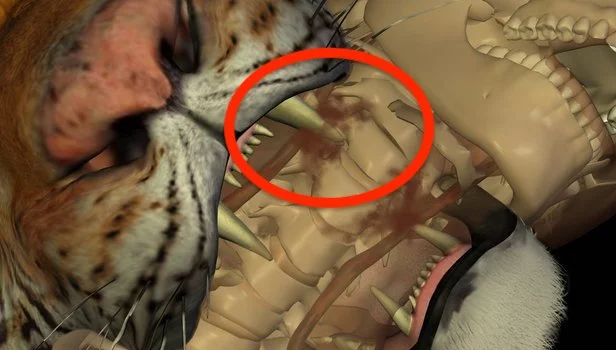The tiger has two basic techniques for killing prey and they are dependent on the size of the animal. Smaller animals are normally killed with a bite to the back of the neck. Larger animals are suffocated by a bite to the throat.
Neck bite

This is much like the domestic cat’s bite to kill birds. A canine tooth is inserted between the prey’s neck vertebrae which breaks the spinal cord. As for domestic cats, tigers can sense where to insert the canine teeth because they have numerous sensors such as mechanical-receptors associated with the canine teeth and whiskers probably play a role too. They are incredibly sensitive and act like fingers touching the prey. It is thought that tigers feel for the gaps in a prey’s vertebrae with the tips of their canine teeth. The bite is precise but not always totally accurate as bone splinters have been seen in killed prey.
Throat bite

This is the safest way for a tiger to kill large prey because big animals have e.g. horns and antlers which are obviously dangerous. The tiger normally bites the throat of the prey just below the junction of the jaw and neck. This crushes the trachea and suffocates the animal. The neck is held close to the ground preventing the animal from resisting by righting itself. Sometimes tigers hold the bite long after the animal has ceased to struggle. It is held for ‘several minutes or longer’.
The throat bit is typical of the big cats killing large prey items. We often see it with lions for instance.
Refs and quote: Wild Cats Of The World page 351 by Mel and Fiona Sunquist.
[weaver_breadcrumbs class=’alt-class’ style=’inline-style’]
[weaver_show_posts cats=”” tags=”tiger-behavior” author=”” sort=”ASC” number=”2″]

